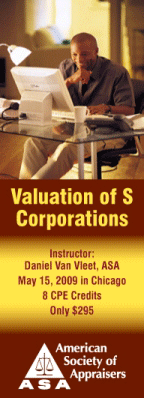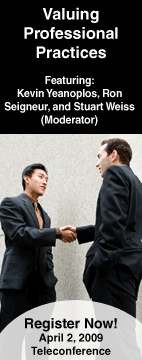
| Use extra caution when determining the cost of capital With U.S. Treasury bond yields low and the expected rates of return high, and the current stock market correction concentrating on the financial services sector and highly leveraged companies, new challenges have arisen in correctly estimating the cost of equity capital (COEC) and the overall cost of capital using traditional methods. To address these issues, Roger Grabowski, managing director of Duff & Phelps, LLC, has published a new paper. Suggestions outlined in Grabowski’s paper range from using a longer-term average T-bond yield when developing an estimate of COEC, to considering an estimated ERP of 6%—which constitutes the upper range of research on long-term ERP—until market conditions improve. In addition, the new Duff & Phelps’ Risk Premium Report explains how to adjust the historic risk premiums for differences between the historic risk premiums observed for the overall market and current, higher forward-looking ERP estimates. Grabowski also stresses the importance of checking the reasonableness of your cost of capital estimates. One method to use, Grabowski says, is the classic Graham and Dodd method, based on corporate bond yields and the application of an average ERP of around 4%. Another method is to apply the data provided in the Duff & Phelps’ Risk Premium Report to estimate the COEC. In particular, Grabowski’s exhibits, showing the historic equity returns based on companies’ average operating margins and their variability, can help quantify the increase in the COEC due to the increased risk of operations. The Duff & Phelps’ Risk Premium Report 2009 is available at BvResources.com. Goodwill equal to half of enterprise value in acquisitions On average, clearly identified intangible assets (such as brands) represented just 23% of enterprise value, while 47% of enterprise value in recent corporate transactions was ascribed to “goodwill,” a new survey from Ernst & Young found. The report, Acquisitions accounting–What’s next for you? A survey of price purchase allocation practices, examines the allocation of transaction values for 709 companies across 21 countries. By ascribing a high proportion of enterprise value to goodwill, many companies are at risk of impairment under current volatile economic conditions. Jim Eales, global head of Valuation & Business Modeling Services at Ernst & Young, explains, “The accounting consequences of these acquisitions need to be carefully considered by acquisitions teams. For each transaction, International Financial Reporting Standards require companies to fair value the tangible and intangible assets acquired. Tangible and amortizable intangible asset values will depreciate as per their life expectancy, affecting future earnings. In the current difficult economic conditions, the goodwill element becomes more susceptible to volatility and write-downs, which can have a significant impact on investor confidence and on the company’s financial health.” Of the areas identified, the consumer products sector had the highest average allocation of enterprise value to goodwill, with 65% attributed to it. The technology sector was next with 60% allocated to goodwill. Tangible assets represented only 9% of enterprise value in the consumer products sector. Among the intangible assets recognized by the buyers, customer relationships and contracts were cited in 44% of deals surveyed. These assets are particularly important in the insurance and telecommunications industry, where transactions are often motivated by the purchase of a client portfolio. Brand (31% of transactions) and technology (20% of transactions) are the other most often identified intangible assets. Upcoming revised standards issued by the International Accounting Standards Board call for fair value measurements and give rise to new challenges for the valuers. Eales explains: “There is a danger the consequences, from an accounting perspective, of these changes will be overlooked until it is too late. One example is contingent consideration. As subsequent changes in contingent consideration will no longer effect goodwill, getting the fair value right at the date of acquisition is critical.” Access historical risk-free rates in seconds—for free! The BVR Risk-Free Rate Lookup™—is a free online tool that allows users to select a date and retrieve historical risk-free, bond, and other rates. The BVR Risk-Free Rate Lookup quickly pulls rates from the Federal Reserve Board’s website and displays them in a table. It also retrieves rates for a selected date, or in the case of a weekend date, holiday, or date where the markets are closed, it will display the rates for the most recent business day. The dates are reported alongside the rates, so the date for the retrieved rates will always be clear. New case considers attorney-client privilege for BV expert communications Recently, two minority shareholders wanted to liquidate their interest in a New York corporation. The company engaged a business appraiser to value the company, and based on his recommendations, it purchased the minority shareholders’ interests for $3 million. Two years later, the company sold for more than $28 million and the minority shareholders sued, claiming that the CEO and the appraiser fraudulently misrepresented the actual value of their stock. During discovery, plaintiffs tried to compel production of communications among the CEO, the appraiser, and the company attorneys, which defendants claimed were subject to attorney-client privilege. The trial court agreed, but ordered their disclosure under a fraud exception. Defendants appealed to the New York Supreme Court (Appellate Div.), which affirmed disclosure on alternate grounds. “Here, all of the communications that the defendants' claim are privileged were made by and between [the appraiser] and attorneys employed by [the company].” The appraiser was neither an agent of the company nor a client of defense counsel. Accordingly, none of the requested communications was subject to the attorney-client privilege, the court ruled. A complete abstract of the case, Seiger v. Zak, 2009 WL 562988 (March 3, 2009) will appear in the upcoming May 2009 issue of Business Valuation Update™. For those in need of the full-text court opinion: BVR has recently completed programming at the BVLibrary.com website to “link” court case abstracts with their corresponding full-text court opinion. After a user retrieves an abstract using the search engine, a link will be provided at the top of the page to view the full-text court opinion—and vice versa if the user first retrieves the full-text court opinion. A subscription to both products is required for users who want to pass back and forth between the abstract and the full-text opinion. AICPA supports amending Federal Rules to protect communications and drafts between BV experts and attorneys During the past year, the Judicial Conference’s Advisory Committees on Appellate Rules, Bankruptcy Rules, Civil Rules, Criminal Rules, and Evidence Rules has been seeking public comment on several proposed rules amendments. Of particular interest to BV experts are the two distinct proposals to amend Rule 26 of the Federal Rules of Civil Procedure (FRCP), according to the Advisory Committee’s preliminary draft:
Public comments to the proposed amendments closed on February 17, 2009. On that date, the AICPA’s Forensic and Litigation Services Committee submitted its official comments endorsing the rule changes, for three primary reasons:
Another enhancement to the Butler Pinkerton Model™ (BPM) Based on feedback from attendees to presentations on the BPM, Pete Butler and Keith Pinkerton have created an e-book in collaboration with Morningstar. The Butler Pinkerton Model Report, is a compilation of the theory behind the technique. The report offers never-before published data, including a table illustrating the range of company-specific risk premiums (CSRPs) as well as total costs of equity (TCOE) for selected standard industrial classification (SIC) codes as frames of reference. The e-book is available for purchase on Morningstar’s website. It is also available without charge to subscribers to the TCOE/Company-specific Risk Calculator. BVR kicks off its new ‘In the Industry Spotlight Series,’ with teleconference on valuing professional practices As part of its new ‘In the Industry Spotlight Series,’ BVR will host teleconferences focused on the valuation of specific industries, businesses, and business models. With each new edition, top BV experts and thought-leaders will guide listeners through the characteristics of the target industry and offer insights on how to deal with the complications they present to the appraisal process. First up is Valuing Professional Practices, on Thursday, April 2, 2009 at 10:00-11:40am PT/1:00-2:40pm ET. Two CPE credits are available to attendees. During this 100-minute teleconference, Kevin Yeanoplos, Ron Seigneur, and moderator Stuart Weiss, will focus on the hard-to-value aspects of service-oriented professional businesses—including issues relating to personal versus professional goodwill, cost of capital, the valuation of intangible assets, and the excess earnings method. This teleconference is necessary for any appraiser called to value the work of doctors, lawyers, dentists, insurers, CPAs, consultants, or any other business whose product is intangible. According to Yeanoplos, “whether [appraisers] have or haven’t been involved in a professional practice valuation, at some point, they will.” To register and listen to Yeanoplos describe the program, click here.
|
To ensure this email is delivered to your inbox,
please add editor@bvwire.com to your e-mail address book.
We respect your online time and privacy and pledge not to abuse this medium. To unsubscribe to BVWire™ reply to this e-mail with 'REMOVE BVWire' in the subject line or click here. This email was sent to %%emailaddress%%
Copyright © 2009 by Business Valuation Resources, LLC
BVWire™ (ISSN 1933-9364) is published weekly by Business Valuation Resources, LLC
Editorial Staff | Advertise in the BVWire | Copyright Notice
|
|


